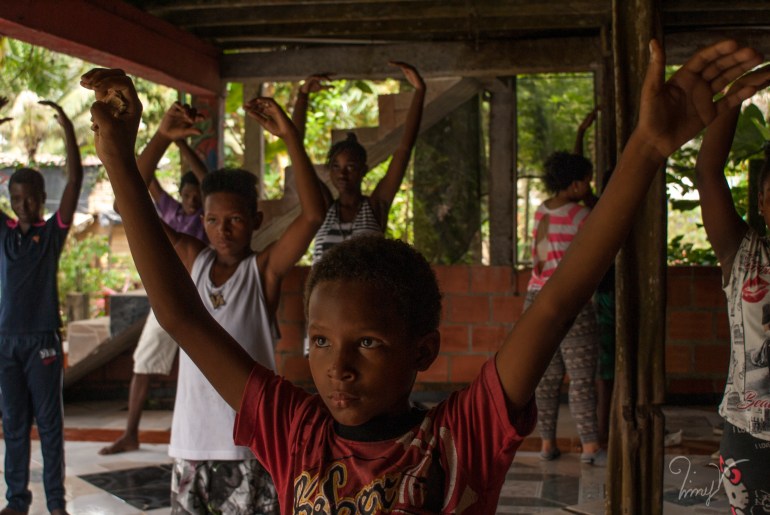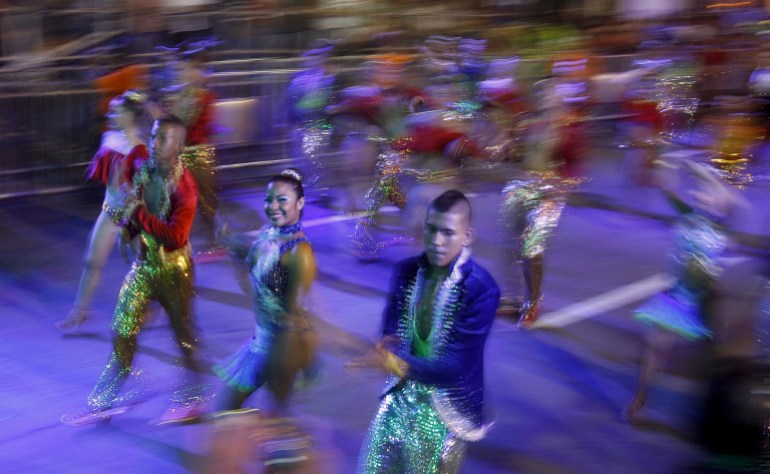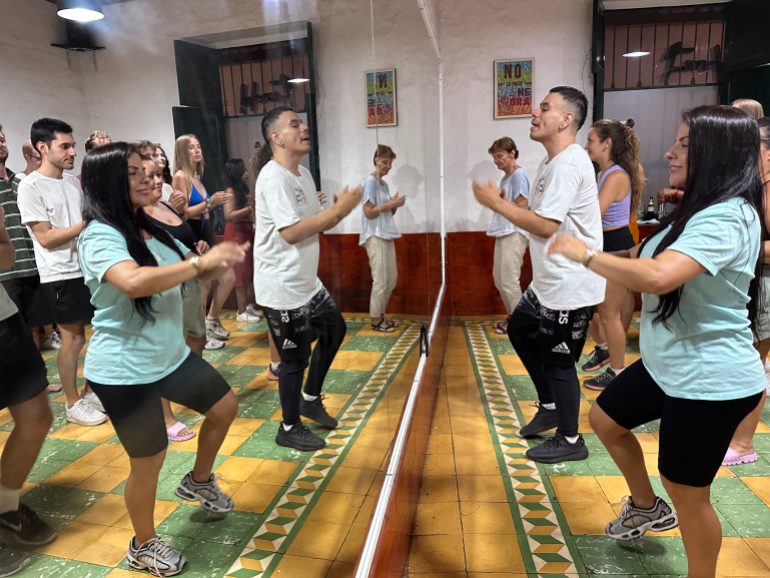Cali, Colombia – As the one sister to 9 brothers, Carmen Diaz loved a boisterous childhood within the port metropolis of Buenaventura, Colombia. Collectively together with her siblings, she would wreak havoc round the home or exit within the streets and kick a ragged ball round for hours.
“I adored playing football,” mentioned Diaz, who requested to be known as by a pseudonym.
However her joyful, rambunctious childhood got here to an finish when her uncle began to sexually abuse her, she mentioned. The assault continued over a number of events.
When she instructed her mother and father about what occurred, they refused to imagine her and as an alternative accused her of mendacity. Feeling distraught, Diaz determined to run away from house on the age of 13.
Diaz ended up sleeping on the streets of the close by metropolis of Cali and have become hooked on medicine. Ultimately, she discovered shelter by way of town’s social providers, which related her with assets for minors.
That’s how she found her lifeline: salsa dancing. It was a part of an experimental remedy challenge run by the native nonprofit, Mi Cuerpo Es Mi Historia, a reputation that interprets to “My body is my story”.
The challenge combines salsa dancing and psychotherapy to assist survivors of sexual violence specific their feelings and course of their trauma over the course of a number of months.
“Dancing can help to heal trauma,” mentioned challenge founder Martha Isabel Cordoba Arevalo, a psychologist and avid dancer who was born and raised in Cali, often called the world capital of salsa.
“When survivors do not want to speak about what happened to them, or if they are not able to, movement gives them a different way of expression.”

Over the previous decade, Mi Cuerpo Es Mi Historia has labored with roughly 700 younger ladies, principally by way of referrals from metropolis providers. Remedy begins with efficiency lessons, specializing in performing, singing or dancing.
Then, the following step is to let members discover subjects they selected by way of efficiency strategies. By the top of the programme, organisers hope the artwork will be an outlet for members to know and deal with their experiences.
Recovering from trauma, nevertheless, isn’t simple or easy. Arevalo remembers assembly Diaz, now 28, when she was solely an adolescent, newly referred to the programme. She noticed that Diaz appeared aggressive — damage by all that she had endured — and didn’t need to work together with the programme’s psychologists.
“I was afraid of men,” mentioned Diaz. “The male psychologists I spoke to, they made me scared.”
However Arevalo quickly found that Diaz had a pure expertise for salsa. Week by week, {the teenager} appeared extra relaxed.
The quick tempo of salsa’s tumbao beat stored Diaz’s thoughts — and her heels — busy, as she flicked throughout the dance ground, her physique swaying to the sound of trumpets and timbales.
“When I was dancing, I felt free and happy,” Diaz mentioned. “It was the best treatment for me. I don’t feel like a victim any more. I am a survivor.”
A rising physique of analysis helps the declare that dance and motion can have advantages for the thoughts, in addition to the physique.
A overview of 41 research printed within the journal Frontiers in Psychology in 2019 discovered that dance motion remedy diminished anxiousness and melancholy, “consistently” bettering associated situations.
Dita Federman, a dance motion therapist who has researched sexual abuse, argues this unconventional therapy methodology can attain some sufferers in methods different interventions can’t.
“It can be crucial in helping some patients,” mentioned Federman. “Dance therapy can lead to increased heart rate, using coordinated movement and balance, and what happens while dancing is that people are more likely to recall and express past memories.”

However Arevalo cautioned that addressing sexual violence is extraordinarily complicated and that no easy resolution exists.
“You need time and resources, and you need trained professionals in order to make deep modifications or restorations of lives,” she mentioned. “Not everyone has that luxury.”
Federman additionally warned that, in each sort of remedy, there’s a threat of re-traumatisation. Dance is not any exception.
“It should be done very slowly, without directly questioning [the survivors] for emotional material,” she mentioned. “If it comes up from them, then it comes up. But it shouldn’t be forced.”
And whereas there was analysis into its efficacy, Federman mentioned information about dance motion remedy stays restricted due to the issue in acquiring permission to check survivors of sexual violence.
“There’s so much we don’t yet know,” she mentioned.
However proponents imagine dance remedy might assist make small steps in responding to the stark ranges of gender-based violence in Colombia.
One third of ladies within the Latin American nation have suffered bodily or sexual violence by the hands of a associate, based on the United Nation’s World Database on Violence.
Colombia’s six-decade-long inner battle has additionally contributed to excessive charges of sexual violence. In September, the Particular Jurisdiction for Peace — a courtroom set as much as examine crimes dedicated throughout the battle — introduced that at the least 35,178 individuals had suffered gender-based violence between 1957 and 2016.
Proper-wing paramilitary teams had been liable for the most important variety of incidents, at roughly 33 p.c. Ladies made up the overwhelming majority of the victims, comprising 89 p.c total.
“The bodies of women have been used as a target of war,” mentioned Arevalo.
To scale back the danger of re-traumatisation, Arevalo avoids utilizing “direct” dance companions in her classes with younger survivors. As a substitute, the dancers study their steps in a bigger, coordinated group. And after they pair up, they typically use a way known as “mirroring”, whereby dancers replicate their associate’s strikes at a distance.
Arevalo mentioned there’s additionally loads of room for particular person improvisation in salsa, which will be danced alone in addition to with others.

Her nonprofit features a pathway for sexual assault survivors to change into salsa instructors themselves, to allow them to move alongside their strategies to others — and even arrange their very own enterprise.
Sofia Murillo is among the many graduates of that programme. On a current December afternoon, she and her fellow trainer Alexander Patiño defined the essential salsa steps to about 25 vacationers in a packed dance studio lined with pale yellow and inexperienced tiles.
Cali’s model of salsa is famously fast-paced: Within the Seventies, it turned widespread for DJs to play information at 45 revolutions per minute, a lot faster than the standard pace of 33rpm.
Confronted with Cali’s whip-fast beats — the galloping pulse of the bongos and cowbells seemingly unrelenting — Murillo’s college students struggled to maintain up. Their toe faucets and turns risked turning into collisions and crushed ft.
However by the top of her class, each one of many vacationers was in a position to cobble collectively a decent routine.
“I had negative thoughts in the past,” mentioned Murillo, 40, who turned a salsa trainer in 2023. “I was mistreated. But when I’m dancing, it’s different. I forget everything. I smile.”

